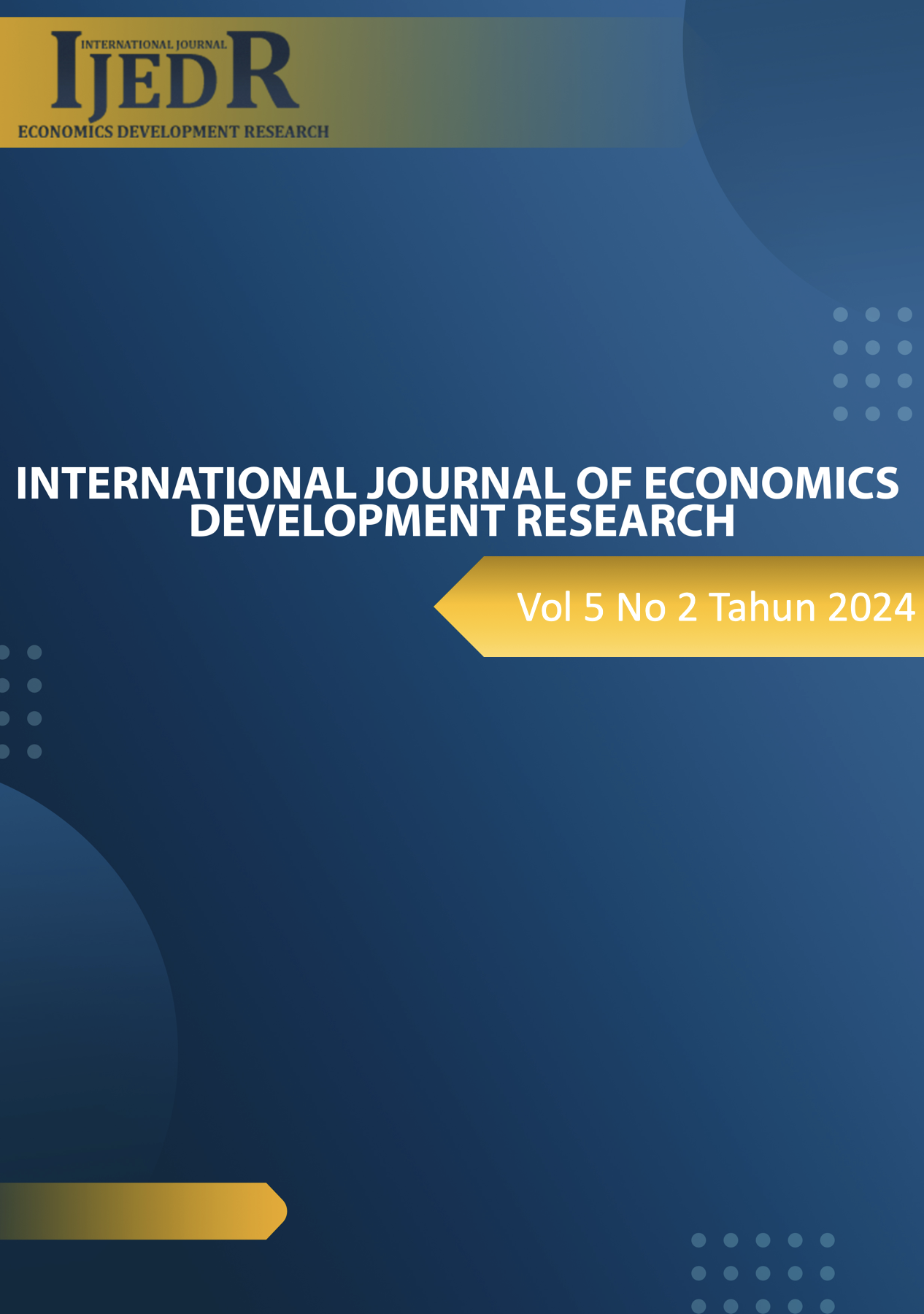Factors Affecting Loan Quality on Sharia Fintech Lending Platforms: A Case Study In Indonesia
DOI:
https://doi.org/10.37385/ijedr.v5i2.5326Keywords:
Fintech Lending, Sharia Fintech, Loan Quality, Financial Services AuthorityAbstract
This study aims to see the Factors Affecting Loan Quality on Sharia Fintech Lending in Indonesia. This research uses a qualitative method of case studies by collecting secondary data through from OJK. This article looks at the Factors of current loans and non-current loans starting in early 2021 to 2023 for Sharia FinTech in Indonesia by adopting the multiple linear regression method and dummy variables to analyze data on more than two free variables. The estimates show factors for gender, age and domicile in FinTech lending in Indonesia. Furthermore, gender does not appear to significantly impact the number of loan recipients or the outstanding loan amount, age and domicile variables have a significant impact on these factors. Age categories show a positive impact on the number of loan recipients and the outstanding loan amount. Meanwhile, individuals outside of Java are more likely to be loan recipients compared to individuals in Java. These findings recommend that financial services authorities intensively encourage new innovative Sharia FinTech business models for lending to expand digital financial inclusion by providing financing for people (P2P) who are not touched by banks.
References
Achsien, I. H., & Purnamasari, D. L. (2016). Islamic crowdfunding as the next financial innovation in Islamic finance: Potential and anticipated regulation in Indonesia. European Journal of Islamic Finance, 5(June), 1–11.
Berg, T., Fuster, A., & Puri, M. (2021). FinTech lending. Swiss Finance Institute Research Paper Series N°21-72.
Chavan, P., & Gambacorta, L. (2016). Bank lending and loan quality: The case of India. BIS Working Paper, 595, 1–33.
Demiray, B., & Bluck, S. (2014). Time since birth and time left to live: Opposing forces in constructing psychological wellbeing. Ageing and Society, 34(7), 1193–1218. https://doi.org/10.1017/S0144686X13000032
Etikan, I. (2016). Comparison of convenience sampling and purposive sampling. American Journal of Theoretical and Applied Statistics, 5(1), 1. https://doi.org/10.11648/j.ajtas.20160501.11
Gautam, R. S., Rastogi, S., Rawal, A., Bhimavarapu, V. M., Kanoujiya, J., & Rastogi, S. (2022). Financial technology and its impact on digital literacy in India: Using poverty as a moderating variable. Journal of Risk and Financial Management, 15(7). https://doi.org/10.3390/jrfm15070311
Hasna, & Syamlan, Y. T. (2021). Analyzing the intention of borrower to use fintech lending. Ekonomi Islam Indonesia, 3(2). https://doi.org/10.58968/eii.v3i2.26
Hu, X. (2023). Inclusive FinTech lending via contrastive learning and domain adaptation. In arXiv '23: arXiv Preprint, 2023, Online (Vol. 1, Issue 1). Association for Computing Machinery.
Ilmiah, J., & Islam, E. (2023). Fintech peer-to-peer lending berbasis syariah sebagai alternatif permodalan UMKM Sidoarjo. 9(01), 1438–1447.
Isa, M., & Suryomurti, W. (2023). Sentiment analysis on the perception of sharia fintech in Indonesia. Atlantis Press International BV. https://doi.org/10.2991/978-94-6463-176-0_11
Laldin, M. A., & Djafri, F. (2019). Islamic finance in the digital world: Opportunities and challenges. Journal of Islam in Asia, 16(3), 283–299.
Latifah, S. W., & Jati, A. W. (2023). The use of sharia fintech on MSMEs performance: Mediation of interest in use of transactions. Jurnal Reviu Akuntansi Dan Keuangan, 13(2), 463–480. https://doi.org/10.22219/jrak.v13i2.23419
Martins, F. S., Cunha, J. A. C. da, & Serra, F. A. R. (2018). Secondary data in research – Uses and opportunities. Revista Ibero-Americana de Estratégia, 17(04), 01–04. https://doi.org/10.5585/ijsm.v17i4.2723
Milawati, ., & Indartono, S. (2020). Indonesian Islamic banking innovation strategy in the digital economy era. Unicees 2018, 661–666. https://doi.org/10.5220/0009511706610666
Naseri, R. N. N., & Rahmiati, F. (2022). What is a population and sampling technique used in intention towards online halal cosmetic purchasing research? International Journal of Academic Research in Business and Social Sciences, 12(5), 707–712. https://doi.org/10.6007/ijarbss/v12-i5/13301
Nemati, A., & Bayer, J. M. (2007). Gender differences in the use of linguistic forms in the speech of men and women: A comparative study of Persian and English. Language in India, 7(9), 1–1. http://ezproxy.lib.monash.edu.au/login?url=http://search.ebscohost.com/login.aspx?direct=true&db=ufh&AN=26886207&site=ehost-live&scope=site
Oliver, R. (2018). Impact of digital finance on financial inclusion and stability. Borsa Istanbul Review, 18(4), 329–340. https://doi.org/10.1016/j.bir.2017.12.003
Surucu, L., & Maslakci, A. (2020). Business & Management Studies: An International Journal, 8(3), 2694–2726.
Takidah, E., & Kassim, S. (2022). The shariah compliance of Islamic peer-to-peer (P2P) lending practices in Indonesia: Identification of issues and the way forward. ICR Journal, 13(1), 72–91. https://doi.org/10.52282/icr.v13i1.830
Wiguna, Y. P. K., & Wirdyaningsih, W. (2022). Analysis of the use of sharia financial technology (Fintek) services study on application services at Pt. Ammana Fintech Shari’Ah according to the fatwa of Dsn Mui and Islamic law. Jhss (Journal of Humanities and Social Studies), 6(2), 185–192. https://doi.org/10.33751/jhss.v6i2.5406
Wook, I. (2015). The Aboriginal Peoples Act 1954 and the recognition of Orang Asli land rights. UUM Journal of Legal Studies, 6(1), 63–83. https://doi.org/10.32890/uumjls.6.2015.4587
Yahya, A. (2021). Sharia fintech development in Indonesia. https://doi.org/10.4108/eai.17-7-2020.2302984
Yao, L., & Yang, X. (2022). Can digital finance boost SME innovation by easing financing constraints? Evidence from Chinese GEM-listed companies. PLOS ONE, 17(3), 1–20. https://doi.org/10.1371/journal.pone.0264647
Zhang, Z. (2022). Research on the impact of digital finance on China’s urban-rural income gap. Review of Economic Assessment, 1(1), 63–75. https://doi.org/10.58567/rea01010005





